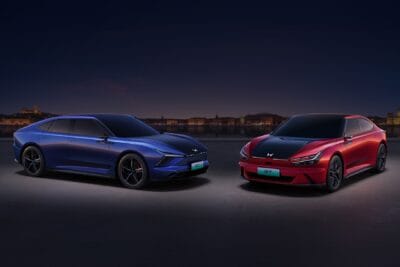
Juniper review: How Tesla has tuned the Model Y for comfort
Does Tesla have something to hide lately? It certainly seems that way. When you first look at the new Model Y Juniper, there’s a conspicuous lack of a logo or brand lettering. Having said that, it certainly benefits the smoothly polished and extremely modern-looking front – with a light strip now spanning its entire width. In any case, there is no longer any sign of the unconventional curves of its predecessor. Clarity also reigns at the rear. The entire section looks as if it has been cast from a single mould – and in practical terms, it has. The rear lights are fully integrated into the tailgate. The days of imperfect gaps are over. The LED bar, which casts a red glow onto the rear at night, is similarly seamlessly integrated.
With the Juniper facelift, the interior of the Tesla Model Y has finally come of age. High-quality materials, accentuated surfaces and the absence of cheap plastic give the electric car a premium edge over its predecessor. The workmanship (and the seats) are also impressive. Designers and engineers have taken an already good electric car – the Model Y was the world’s best-selling car in 2023 and 2024 for a reason – and made it a very good electric car. And best of all: unlike the Model 3 Highland, which I drive everyday, there is a turn signal lever – and thus, I can finally signal again at roundabouts. Even if I accidentally activated the windshield wipers more than once when the sun was out – because where the Model 3 Highland has a turn signal, the Model Y Juniper now has wipers.
Comfort inside and out
The added comfort is also noticeable when driving. Where once every root bulging out of the road surface tortured the spine, the car now only rocks gently. Compared to the tightly tuned Model 3 Highland, the Model Y Juniper is a back-friendly everyday companion. Of course, the suspension is still far from some German air suspension – but it is no longer a hooligan either. What’s more, it’s now much quieter thanks to better sealing and double glazing. Wind noise has noticeably decreased. The steering also feels more precise than before, which is likely due to the modified front wheel suspension.
The electrically adjustable (split) rear seat is also extremely practical for everyday use. It can even be operated from the boot using a switch, lowering and raising it. That is another difference compared to its predecessor, because the backrests had to be folded up manually. Some drivers will be pleased to manage the up to 2,140 litres of loading volume so easily. In this price range – our test car aka the ‘Launch Series’ starts at 60,990 euros in Germany, and the ‘regular’ Model Y with this drive at 52,990 euros – features like this are rarely found in series production. The new display in the second row is also useful. When in park mode, anyone sitting in the rear right seat can move the front passenger seat forward as needed. Great fun for siblings, we can reveal that much. But only for those sitting in the back.










Digital support is also further developed. For example, if you are driving at a constant speed on the motorway, the onboard system occasionally asks if you would like to activate the Autopilot. How attentive! Speaking of attentive: when driving on Autopilot, a quick glance at your mobile phone is enough to receive a reprimand. Tesla doesn’t dither for long here. On the other hand, the new arrival energy specification, which you can change at any time when route guidance is active, is friendlier.
Not a brilliant feat at the Supercharger
On the other hand, little has changed in terms of hardware. On paper (aka WLTP), the almost 4.80-metre-long electric crossover has a range of 568 kilometres – and that’s even with the new 20-inch rims (586 km with the 19-inches) – but in everyday life, the 35 kilometres hardly make a difference. Especially since the familiar behaviour at the Supercharger: Model Y gets off to a strong start, but the charging curve drops rapidly after just a short time. During our test, the warm battery (in wintery outside temperatures on the motorway, it had previously been run down to 3 per cent charge) reached its peak at 234 kW after a short time and then slowly slowed down. In practice, you can expect the usual 30 minutes at the Supercharger for a long-distance hub to about 80 per cent. That is still practical, but many other manufacturers (whether German, Korean or Chinese) now offer a faster charging speed. The fact that Tesla has remained loyal to its 400-volt system cannot be seen as an increase in comfort, but as persistence.
And the consumption? Depending on driving style, dynamics and traffic, everything from 17.5 to 26.3 kilowatt hours per 100 kilometres was possible. When we returned the car, the onboard computer showed an average consumption of 21.7 kWh for the past 800 kilometres. That is solid for an electric car of this size, but unlike a few years ago, it is no longer a benchmark.
Conclusion
The Tesla Model Y Juniper is not a revolution, but it is an important evolution of what is still the most popular electric car in the world. All areas have been meaningfully and sustainably revised. In everyday life, you will lack for nothing with this car. The comfort is spot on, the new look is dynamically modern at the front and luxuriously full at the rear. And with the Supercharger charging network and the very good smartphone app, it still has the most sophisticated ecosystem. Whether the new Model Y will build on the success of the old one will probably not be decided by the car (at least in Europe) – but by Elon Musk’s behaviour.




2 Comments